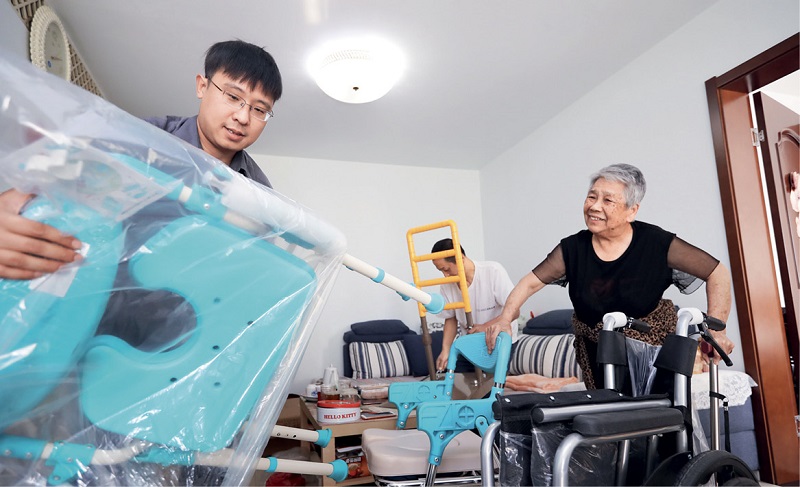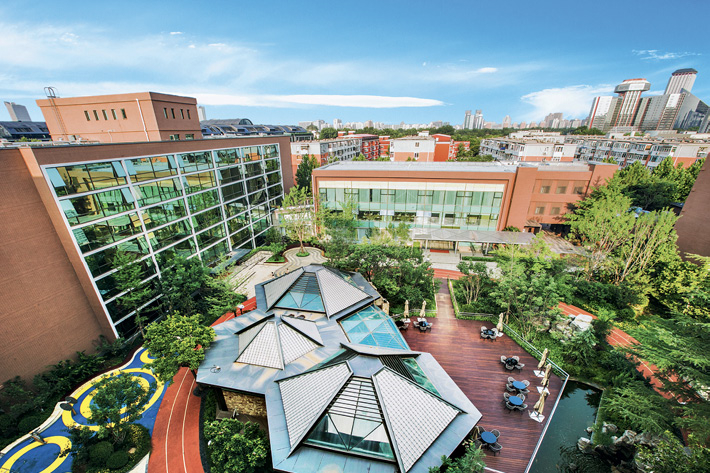With the continuous expansion of the demand in China for the integration of medical care and elderly care, more social capital will be directed into this field.
Although answers to the question “What is happiness?” may vary among young people, for most senior citizens the answer is by and large the same: to be looked after properly.
Shanghai proposed a goal for elderly services in 2005 called “9073”, which means 90 percent of the elderly being cared for at home, seven percent of them in community-based care, and three percent in institutions. However, a survey by the Beijing Municipal Civil Affairs Bureau in 2023 showed that more than 99 percent of the elderly in Beijing choose to age at home, and less than one percent in nursing institutions for the elderly.
There is still much to be done to optimize the layout of elderly services, explore a new model that combines diverse medical care and elderly care, and address the problems of inconvenient medical treatment at home and hospitals.

Workers are installing facilities for elderly care services at the home of an 88-year-old Tianjin model worker (right) on October 16, 2023.
Accessible Community Hospitals
“Now, I can see a doctor and get medicine within 10 minutes. This is so convenient for seniors!” Wei Pei, who lives in Yuzhong District, Chongqing, expressed happily that high-quality medical resources are now accessible in his community, making it possible for residents to seek medical treatment right near their homes.
Wei has suffered from chronic hypertension for many years. Under the direction of his family doctor Lü Jun at Shangqingsi Subdistrict Community Healthcare Center, he has regular check-ups and gets prescribed medications, and as a result has been able to keep his blood pressure under control. “We have also established a WeChat group, where residents can consult with doctors online at any time. Family doctors answer questions in a timely manner and provide in-home services when needed,” Lü introduced.
Chongqing has the second largest population aging rate nationwide. Yuzhong District is expected to have a permanent population of 568,000 by the year 2025, and 22.01 percent of that will be aged 60 and above. The question of how to make good use of urban resources to provide high-quality medical services for the elderly is now a key task of the government.
The Shangqingsi Community Healthcare Center is an excellent example of Chongqing's efforts to create a “10-minute medical and health service circle.” It includes an expert clinic, general clinic, traditional Chinese medicine department, chronic disease management department, and other departments. According to Zhong Yu, director of the center, the facility covers seven neighborhoods with a total permanent population of 52,185. Residents in the district can reach the center within 10 minutes.
Over the past few years, the community health care service sector has gradually become a major branch of the health industry. This is due to the fact that China has always attached great importance to the needs of its aging population and promoting medical and elderly care services in the overall national development. According to the 14th Five-Year Plan (2021-2025), China will promote the coordinated development of old-age care programs and the elderly care industry, and build a service system that coordinates home care and community institutions and combines medical care with health care.
The effects of the multiple measures taken by Yuzhong District are very evident. By the end of 2022, an additional 11 community healthcare centers and 17 community health service stations were set up in Yuzhong District, making it possible for more residents to enjoy convenient basic medical care and healthcare services in their own communities.
Creating New Models
Due to the challenge of population aging, elderly services have become increasingly subdivided, with countless competitors in home-based care, community endowment, and old-age care provided by institutions. In this context, insurance companies have targeted elderly care communities, creating a new model of “insurance + service,” and are exploring feasible profit models.
“I’ve been living here for two and a half years, and life here is all very convenient from satisfying daily services to getting professional medical care, just like at home,” said 83-year-old Sun, who lives in Beijing Chaoyang Chengxin Community built by Dajia Insurance Group Co., Ltd.
Unlike other insurance companies that build similar communities in the suburbs, Dajia is exploring a new path of leasing property in urban areas to build elder care communities with relatively little overall investment and a short payback period. Through market research, Dajia learned that the elderly are reluctant to stay away from their families while at the same time also want to be close to quality medical resources. Based on the market demand, it has chosen the development model of helping elderly people stay close to medical resources and their families.
“In addition to relying on nearby hospitals, our community has set up medical departments that are equipped with more than 30 medical staff, providing high-quality medical, rehabilitation, and nursing services, and can also be covered by health insurance,” said Yang Shu, general manager of the operation and management section of Dajia Health and Elderly Care Industry Investment Management Co., Ltd. By the end of 2023, 620 elderly people had been accommodated into the Chaoyang Chengxin Community, with an occupancy rate of more than 95 percent.
As a high-quality elderly care community, Chengxin Community has built a health care service system that is modularized with specialization. It has launched eight service modules — medical treatment, rehabilitation, nursing, recreation, travel, accommodation, meals, and healing, and formed a customized service plan according to the specific situation of each elderly person. The accommodation fee is RMB 10,000-20,000 per month, and the meal fee is RMB 1,800 per month, which meets the medical and nursing needs of high-income customers.
After four years of operating under this model, the elderly service network which Dajia has invested in has begun to take shape. Presently, it has set up 13 medical care communities in 11 cities such as Beijing, Nanchang, Tianjin, Chengdu, Taiyuan, Changsha, Jinan, and Hangzhou. By exploring different ways, it has blazed a new development path for the pension industry in the new era.

An aerial view of Beijing Chaoyang Chengxin Community, a new model of helping elderly people stay close to medical resources and their families.
Promising Remote Consultation
Relying on the data platform of the National Telemedicine and Connected Healthcare Center, the Telemedicine Center of Beijing Geriatric Hospital was built in 2019, which is committed to providing high-quality, standardized, convenient, and efficient health services for the elderly in Beijing’s residential communities and elderly care institutions.
“In response to the health service needs of elderly care institutions, we have built a remote collaborative service platform for the integration of medical care and elderly care in Beijing,” said Liu Xiaopeng, vice president of Beijing Geriatric Hospital. Working with 17 district-level medical institutions, it has been able to network 17 district elderly health and medical care service guidance centers and more than 100 medical and elderly care institutions, and already built the core structure of Beijing's elderly health system, with a potential huge space for industrial development.
By the end of 2022, there were about 4.65 million permanent elderly residents in Beijing, accounting for 21.3 percent of its total permanent population. This means the city has entered a moderately aging society. “At present, Beijing has 640 more people over the age of 60 every day, and at this rate, it will only take 10 years for Beijing to develop from a moderately aging society to a severely aging society,” said Wang Xiao’e, member of the Party Committee of the Beijing Municipal Health Commission.
According to Liu Xiaopeng, Beijing Geriatric Hospital has abundant medical resources, and clinical experts from different specialties can provide diagnosis and treatment services for the elderly through the remote platform. Currently, the platform mainly provides services such as remote health consultation, health warnings, and online public education. In the future, the hospital plans to promote high-quality medical resources to more regions on the basis of serving the Beijing-Tianjin-Hebei region.
Meeting the medical needs of the elderly has always been the core objective of China's aging industry. By 2030, China’s aging population over 60 years old will reach 400 million, and the aging industry will reach a value of nearly RMB 13 trillion. In Japan, the silver economy is worth US $ 1.1 trillion, almost double what it was 20 years ago and accounts for nearly 50 percent of all consumption. Similarly, the EU’s silver economy is growing at an annual rate of five percent. International experience shows that although population aging has brought many challenges to society, it has also created a new market space for the silver economy.
Just like Chinese President Xi Jinping pointed out, as China responds proactively to its population aging, the country will introduce policies to foster a social environment in which senior citizens are respected, cared for, and live happily in their later years. China will provide integrated elderly care and medical services, and accelerate the development of old-age programs and industries.
In the future, with the continuous expansion of elderly demand for the integration of medical care and elderly care, more social capital will be directed into this field, which will also transform it into a new driving force for domestic economic growth and supply-side reform.